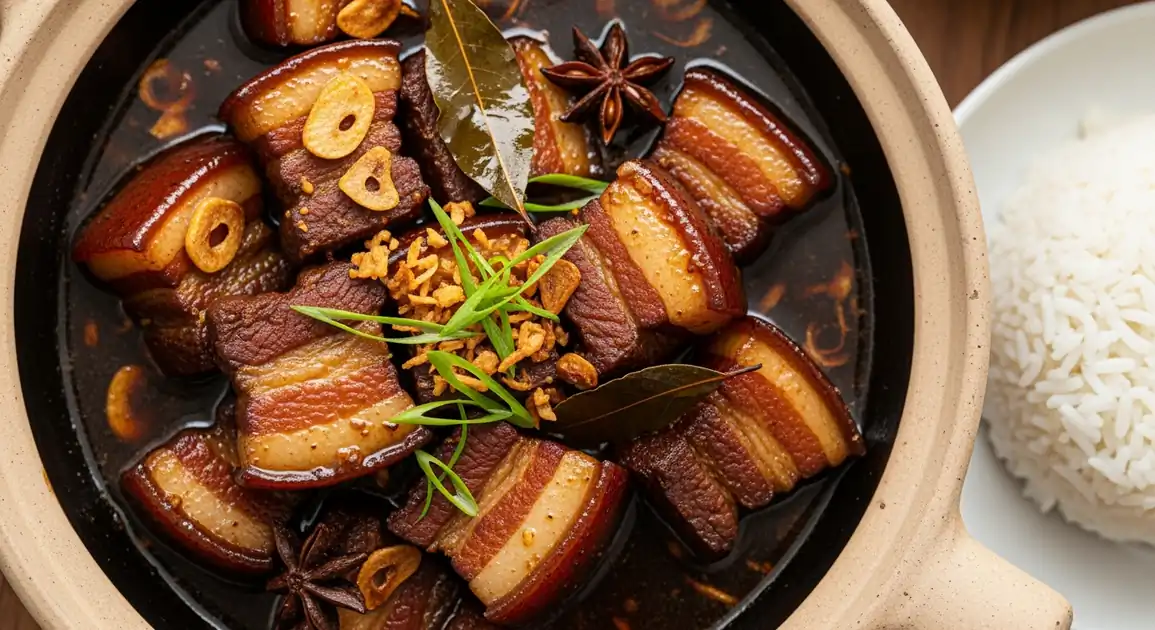Humba Bisaya (Filipino Sweet Braised Pork)
Humba Bisaya

Description
Bohol takes particular pride in its Humba Bisaya, with the island province offering some of the most authentic versions of this beloved dish. Here, Humba remains true to its Visayan roots, typically featuring the traditional combination of fermented black beans (tausi) with a perfect balance of sweet and savory. Bohol's version tends to be less sweet than those found in Manila or other regions, focusing instead on the rich pork flavor complemented by aromatic spices.
Dietary Information
Serving information
Serving style
In local eateries, served on plates with rice. Tourist restaurants often present it in small clay pots (palayok) or coconut shells for added authenticity. Sometimes garnished with spring onions or fried garlic bits.
Quick facts
Local carinderias typically operate 7 AM - 8 PM. Tourist-oriented restaurants serve from 10 AM - 9 PM, with some beach establishments open later until 10 PM.
Safety Tips
What to Look For
-
Freshly cooked or properly reheated Humba
Humba should be steaming hot when served. Since it's often prepared in advance, proper reheating is essential to kill any bacteria that might have developed during storage.
-
Clean serving conditions
Look for vendors who maintain clean serving areas, use proper utensils, and observe good personal hygiene.
-
Glossy, thick sauce
A properly reduced sauce indicates thorough cooking. It should coat the meat nicely and have a slightly sticky consistency, not be watery or separated.
-
Visible star anise or bay leaves
The presence of these spices indicates authentic preparation methods and attention to traditional ingredients.
What to avoid
-
Lukewarm or room temperature Humba
Pre-cooked meat dishes like Humba should not be held at room temperature for extended periods. Avoid if not properly hot when served.
-
Excessively dry or tough meat
Properly cooked Humba should be tender. Dry or tough meat may indicate old, overcooked, or repeatedly reheated food.
-
Sour smell or taste
While Humba contains vinegar, an overly sour smell or taste can indicate spoilage. Fresh Humba should have a balanced sweet-savory aroma.
-
Very oily, separated sauce
The sauce should be integrated, not showing excessive oil separation, which can indicate improper cooking or storage.
Price information
Price range
Budget tips
- Local carinderias away from tourist areas offer Humba for 70-120 PHP per serving.
- Markets in Tagbilaran City like the Dao Public Market have affordable eateries serving authentic Humba.
- Tourist-oriented restaurants charge 200-350 PHP, though portion sizes are usually larger.
- Some guesthouses in Panglao or Tagbilaran offer home-cooked meals including Humba at reasonable prices (150-200 PHP).
Value indicators
- Inclusion of tausi (fermented black beans) indicates authenticity.
- Melt-in-your-mouth pork that's been properly braised.
- A balance of sweet and savory flavors (not overly sweet).
- Generous portion with good meat-to-fat ratio.
- Served with garlic rice rather than plain rice in some establishments.
Where to Find This Dish
Tagbilaran City Center
The provincial capital offers numerous local eateries serving authentic Humba, particularly around the main market areas.
Dao Public Market, Island City Mall food court, BQ Mall area
Lunch, Early Evening
Panglao Island
Tourist area with restaurants serving Filipino classics, though prices are higher than in Tagbilaran.
Alona Beach eateries, Panglao town proper
Lunch, Dinner
Loboc River Area
Restaurants near the popular river cruise often serve Humba as part of Filipino buffets or set menus.
Loboc River Cruise terminal, Restaurants overlooking the river
Lunch (cruise time)
Carmen & Chocolate Hills Area
Local eateries around this tourist destination offer home-style Humba to visitors.
Carmen town proper, Chocolate Hills Complex
Lunch
Vendor Tips
- Ask for 'Humba Bisaya original' to ensure you get the traditional version with tausi rather than a sweeter tourist-adapted version.
- Local markets in Tagbilaran offer the most authentic and affordable versions, especially Dao Public Market.
- Some vendors offer 'Humba sulod' (stuffed Humba) - a specialty where the pork belly is stuffed before cooking.
- Restaurants catering to tourists might reduce the fat content - specify if you prefer the traditional fatty version or a leaner cut.
How to Order
Regional Variations
-
Humba Boholano
(Humba Boholano)
The standard Bohol version featuring a balanced sauce with tausi, star anise, and bay leaves. Less sweet than other regional variations.
-
Humba sa Panglao
(Humba sa Panglao)
Tourist-friendly version commonly found in Panglao Island, often with a thicker sauce and sometimes including local tropical fruits like coconut or banana heart.
-
Humba Sulod
(Humba Sulod)
A special Bohol variation where the pork belly is butterflied and stuffed with a mixture of ground pork and vegetables before being rolled, tied, and braised in the traditional Humba sauce.
-
Humba sa Baha-Baha
(Humba sa Baha-Baha)
Named for the way the meat is 'flooded' in sauce, this variant features more sauce than usual, perfect for pouring over rice. Popular in local carinderias.
Cultural context
History
Humba Bisaya reflects the Chinese influence on Filipino cuisine, especially in the Visayas region. The name derives from the Hokkien Chinese words 'hong' (meaning to braise) and 'bah' (meaning meat). While similar to the Chinese red-braised pork (hong shao rou), Humba evolved distinctly with local ingredients and preferences. It became a staple in Visayan households, particularly in Cebu and Bohol, and is often prepared for special occasions and fiestas. Each family typically has their own version, with recipe variations passed down through generations.
Local significance
In Bohol, Humba represents family heritage and is often made according to closely guarded family recipes. It's considered one of the provincial dishes that showcases Boholano culinary expertise and their connection to broader Visayan food traditions.
Eating customs
- In Bohol, Humba is sometimes eaten with puso (hanging rice) instead of plain rice, especially in more traditional settings.
- Local eating customs include balancing the rich Humba with simple vegetable sides like pinakbet or ensaladang talong (eggplant salad).
- When eating in a group setting, it's customary to leave some portion for others rather than taking the last piece.